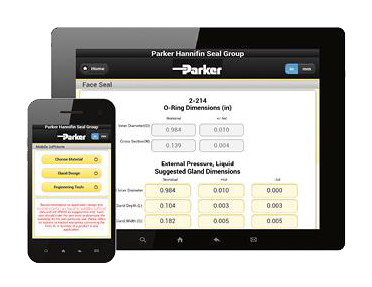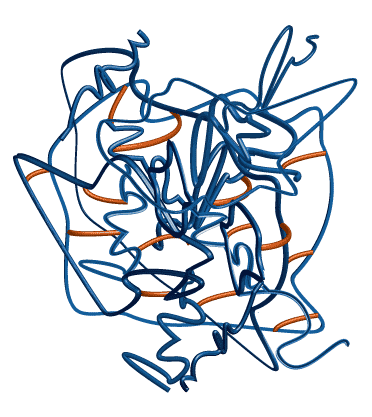What is an O-ring?
An O-ring is a torus, or doughnut-shaped ring, generally molded from an elastomer, although O-rings are also made from PTFE and other thermoplastic materials, as well as metals, both hollow and solid. This handbook, however, deals entirely with elastomeric O-ring. O-rings are used primarily for sealing. The various types of O-ring seals are described in the section called “Scope of O-ring Use.” O-rings are also used as light-duty, mechanical drive belts. More information, including design criteria on O-ring drive belts and their application can be found in the O-Ring Applications Section. So what is an O-Ring Seal? An O-ring seal is used to prevent the loss of a fluid or gas. The seal assembly consists of an elastomeric O-ring and a gland. An O-ring is a circular cross-section ring molded from rubber (as shown above). The gland - usually cut into metal or another rigid material - contains and supports the O-ring. The combination of these two elements; O-ring and gland - constitute the classic O-ring seal assembly.

Advantages

- They seal over a wide range of pressure, temperature and tolerance.
- Ease of service, no smearing or retightening.
- O-ring normally require very little room and are light in weight.
- In many cases an O-ring can be reused, an advantage over non-elastic flat seals and crush-type gaskets.
- The duration of life in the correct application corresponds to the normal aging period of the O-ring material.
- O-ring failure is normally gradual and easily identified.
- They are cost-effective.
STATIC O-RING SEALING
It has been said that O-ring are “the finest static seals ever developed.” Perhaps the prime reason for this is because they are almost human proof. No adjustment or human factor comes into play when O-ring are assembled originally or used in repairs if the gland has been designed and machined properly. O-ring do not require high bolting forces (torque) to seal perfectly. O-ring are versatile and save space and weight. They seal over an exceptionally wide range of pressures, temperatures and tolerances. Once seated, they continue to seal even though some feel that they theoretically should not. In addition, they are economical and easy to use. Therefore, we agree that the O-ring is “the finest static seal ever developed.

Static Male and Female O-ring Seal Design
In a static seal, the mating gland parts are not subject to relative movement.
Face Type Seals
When using an O-ring as a face seal, a groove is cut in a flat surface, such as a flange. The O-ring is placed in the groove and a second flat surface compresses the O-ring.
Dovetail and Half-Dovetail Grooves
It is sometimes necessary to mount an O-ring in a face type groove in such a way that it cannot fall out.
Boss Seals
The AS568-901 through -932 O-ring sizes (Parker’s 3- series) are intended to be used for sealing straight thread tube fittings in a boss.
Failures and Leakage
By far the most common type of failure in static O-ring seals is extrusion.
O-Ring Glands for Industrial Static Seals
Calculating gland dimensions of an O-ring.
Dynamic O-Ring Sealing
Dynamic O-ring sealing applications are considerably more involved than static applications due to the implied motion against the O-ring seal interface. Resistance to fluids must be more carefully scrutinized than in conventional static seal designs since a volumetric increase in the O-ring in excess of approximately 20% may lead to friction and wear difficulties and only a minimum of shrinkage (at most 4%), can be tolerated.
The metal or other surface over which the O-ring will move also becomes critical. It must be hard and wear resistant. It also must be sufficiently smooth so that it will not abrade the rubber, and yet there must be small microfine“pockets” on the moving surfaces to hold lubricant.
The greatest dynamic use of O-rings is in reciprocating hydraulic rod and piston seals. These are discussed first, but many of the ideas expressed are also applicable to other dynamic applications.
Millions of O-rings are used very successfully in reciprocating hydraulic, pneumatic, and other fluid systems which employ long stroke, large diameter seals.
In principle, the same conditions for a hydraulic seal apply to a pneumatic seal except that the effects of certain extreme conditions are more serious.
Friction is a complex subject and can be divided into sub-categories that include running friction, breakout friction, wear, lubrication, and more. The full edition of the Parker O-Ring Handbook contains many details addressing each of these topics, as well as in depth calculations for estimating frictional properties.
Temperature in and around a system is significant to the longevity and performance of the seal. Both high and low temperatures must be considered.
An O-ring has proved to be a practical rotary shaft seal in many applications. With the correct design, Parker O-Ring rotary seal compound N1090-85, will provide satisfactory service at surface speeds up to 1500 feet per minute.
The design conditions are most critical for rotary seals, as would be expected. Relatively high durometer compounds, close control of tolerances, and minimum cross section are required.
Mobile inPHorm - Parker's Design Tool & O-Ring Calculator

Parker recommends utilizing our inPHorm design software to guide the user through the design and selection of an O-ring and corresponding seal gland. Parker’s inPHorm not only addresses standard O-ring sizes, but allows the user to custom design O-ring glands and seals specifically for their application. To obtain inPHorm download from www.parkerorings.com. If inPHorm is not readily available manual calculations can be performed using the following guidelines.
Recommended Manual Design Procedure
- Determine the gland design for best sealing results.
- (a) If the fluid medium or its specification is known, refer to the Fluid Compatibility Tables in Section VII or to the various material or other specifications listed in Section VIII.
- (b) If the compound specification is known, refer to Table 8-2, Table 8-3 or Table 8-4 in Section VIII as applicable.
- Find the recommended O-ring size and gland dimensions in the appropriate design table in Static O-Ring Sealing or Dynamic O-Ring Sealing, Sections IV and V, respectively.
- For industrial use, order the O-ring by the Parker compound number followed by the size number. Example: N0674-70 2-325
- For a design problem that cannot be resolved using the information in the software, contact a Parker O-Ring Division Applications Engineer at ordmailbox@parker.com for problem analysis and design recommendations. When ordering parts made with a military, AMS, or NAS specification material, see the Aerospace reference guide.
O-ring Elastomers
The basic core polymer of an elastomeric compound is called a rubber, produced either as natural gum rubber or manufactured synthetically by the chemical industry. Today, more than 32 synthetic rubbers are known, the most important ones are listed here.
Modern elastomeric sealing compounds generally contain 50 to 60% base polymer and are often described simply as “rubber.” The remaining balance of an elastomeric compound consists of various fillers, vulcanizing agents, accelerators, aging retardants and other chemical additives which modify and improve the basic physical properties of the base polymer to meet the particular requirements of a specific application.

Elastomers used in producing seals, and particularly those used in O-ring, will usually provide reliable, leak-free function if fundamental design requirements are observed. What exactly makes a rubber compound behave the way it does? The magic is in "cross-linking". Bridges tie together the polymer chains forming bonds during the vulcanization process, as depicted in the image below. Cross-linking of the molecules changes the rubber from a plastic-like material to an elastic material.
Elasticity is what allows a rubber compound to function as a seal. When a rubber compound is compressed, the "cross-linked" polymer chains are pushed close together. These cross linked bonds want to extend to their original state acting as springs, pushing the rubber compound outwards. The rubber conforms to the gland surfaces and creates a barrier, preventing fluid from crossing, and thus creating a good seal.






